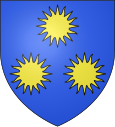Belonchamp
| Belonchamp | ||
|---|---|---|

|
|
|
| region | Bourgogne-Franche-Comté | |
| Department | Haute-Saône | |
| Arrondissement | Lure | |
| Canton | Mélisey | |
| Community association | Haute Vallée de l'Ognon | |
| Coordinates | 47 ° 46 ′ N , 6 ° 37 ′ E | |
| height | 334-680 m | |
| surface | 6.87 km 2 | |
| Residents | 204 (January 1, 2017) | |
| Population density | 30 inhabitants / km 2 | |
| Post Code | 70270 | |
| INSEE code | 70063 | |
| Website | http://belonchamp.cchvo.org/ | |
 Mairie Belonchamp |
||
Belonchamp is a municipality in the French department of Haute-Saône in the region Bourgogne Franche-Comté .
geography
Belonchamp is located at an altitude of 340 m above sea level, 13 kilometers northeast of Lure and about 24 kilometers northwest of the city of Belfort (as the crow flies). The village extends in the eastern part of the department, on the upper Ognon , in the southwestern Vosges , on the edge of the Plateau des Mille Étangs .
The area of the 6.87 km² municipal area covers a section of the southwest Vosges. From northeast to southwest the area is crossed by the alluvial lowland of the Ognon. The flat floodplain lies at an average of 340 m and is around one kilometer wide. It is mainly used for agriculture. In the municipality, the Ognon takes on the Raddon from the east .
The valley of the Ognon is flanked on its west side by the Plateau des Mille Étangs . The plateau is almost entirely wooded and reaches a height of 445 m. In the basin there are numerous small lakes (including the 7-hectare Étang du Rosbeck ), which are predominantly of natural origin and formed during the ice age by glacial grinding . Some have also been dammed up and are used for fish farming. There are also boggy lowlands and heathlands. In the west, the municipal area extends into the basin of the Ruisseau de Mansevillers , another tributary of the Ognon.
East of the Ognon Valley, the densely forested slope rises steeply to the heights of the Montagne de Fresse . At 680 m, the highest point in Belonchamp is reached at La Dame Louise . From a geological and tectonic point of view, the heights in the lower parts consist of crystalline bedrock, in higher areas of red sandstone from the lower Triassic .
The municipality of Belonchamp consists of the following settlements:
- Le Davaux (340 m) on the western edge of the Ognon valley
- Le Damont (343 m) in the valley of the Ognon
- Le Raddon (342 m) at the confluence of the Raddon in the Ognon Valley
Belonchamp's neighboring communities are Ternuay-Melay-et-Saint-Hilaire in the north, Fresse in the east, Saint-Barthélemy in the south and Mélisey in the west.
history
In the Middle Ages Belonchamp belonged to the Free County of Burgundy and in it to the area of the Bailliage d'Amont . The local rule was initially held by the lords of Faucogney, later the village belonged to the barony of Mélisey. Together with Franche-Comté , the village finally came to France with the Peace of Nijmegen in 1678. With the opening of the tram from Lure to Le Thillot (1895), Belonchamp was connected to the public transport network. However, the line was stopped again at the beginning of World War II. Today Belonchamp is a member of the communal association Communauté de communes de la Haute Vallée de l'Ognon, which comprises 12 localities .
Attractions
Worth seeing is a plague cross from granite , which is dated to the 1349th The town center is characterized by several farmhouses from the 17th to 19th centuries that show the traditional style of the region. Only a few remains of two medieval castles are visible.
population
| Population development | |
|---|---|
| year | Residents |
| 1962 | 358 |
| 1968 | 320 |
| 1975 | 262 |
| 1982 | 254 |
| 1990 | 238 |
| 1999 | 202 |
| 2006 | 226 |
| 2016 | 201 |
With 204 inhabitants (January 1, 2017) Belonchamp is one of the small communities in the Haute-Saône department. After the population in the first half of the 20th century had always been between 340 and 380 people, there has been a significant population decline since the beginning of the 1960s.
Economy and Infrastructure
Until well into the 20th century, Belonchamp was mainly a village characterized by agriculture (dairy farming, cattle breeding and arable farming), forestry and fish farming. Today there are some local small businesses, mainly in the textile industry. In the last few decades the village has transformed into a residential community. Many workers are therefore commuters who work in the larger towns in the area.
The village is located off the major thoroughfares on a departmental road that leads from Lure via Mélisey to Le Thillot . Another road connection exists with Fresse.
